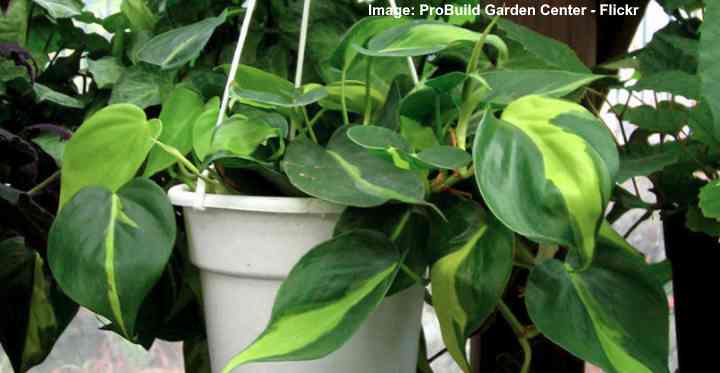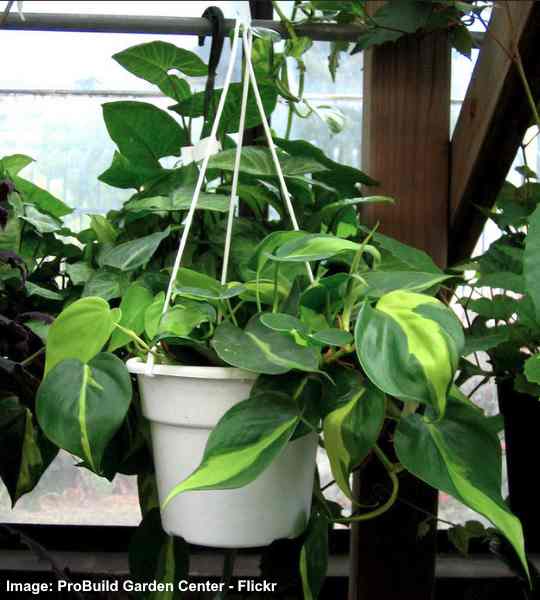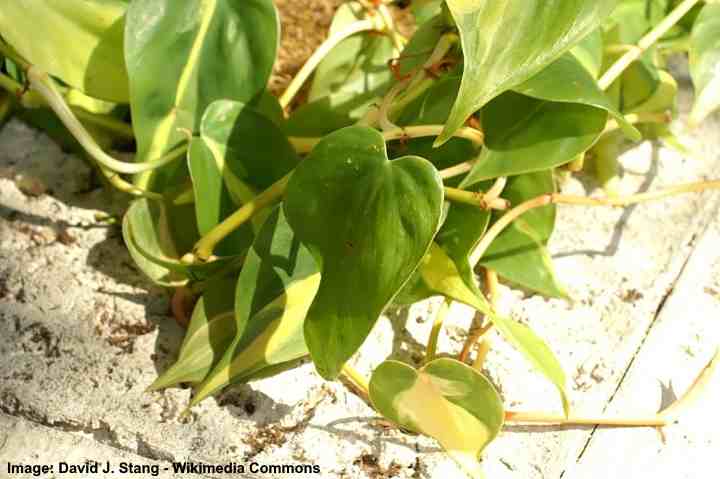Philodendron Hederaceum Brasil: Caring for Philodendron Scandens ‘Brasil’

The Philodendron hederaceum ‘Brasil’ is a climbing plant with large evergreen glossy foliage. The Philodendron ‘Brasil’ cultivar has beautiful variegated green and lime or lemon-colored leaves. This fast-growing heartleaf Philodendron plant thrives indoors with minimal care. Even in low-light conditions or shaded areas, the Philodendron ‘Brasil’ will grow prolifically.
How to care for Philodendron Hederaceum ‘Brasil’: Also called Philodendron scandens, the tropical plant thrives in moist, well-draining potting soil and bright, indirect light. Water when the top part of the soil is dry. A temperature range of between 60°F and 75°F (16°C – 24°C) is ideal. The Philodendron ‘Brasil’ needs medium to high humidity and feeding monthly in spring and summer.
The attractive feature of the Philodendron ‘Brasil’ is its leaves in the shape of hearts. Because of the heart-shaped leaves, the plant is also called sweetheart Philodendron. The eye-catching bright green and golden-yellow foliage and long stems trailing from a hanging basket brighten up the corner of any room. You can grow the climber in a pot and let the stems grow up a moss pole.
Whether you want to gift the plant to symbolize love or you want to grow the Philodendron ‘Brasil’ in your home, this stunning houseplant is sure to please.
What is a Philodendron ‘Brasil’?

In the picture: Philodendron hederaceum ‘Brasil’ with its variegated leaves. Image: Flickr
Philodendron hederaceum cultivar ‘Brasil’ is a tropical plant in the botanical classification Araceae. The plant also has the botanical name Philodendron scandens. Philodendrons are related to species of Monstera, Pothos, and Calla lily plants.
Philodendron hederaceum cultivars are native to tropical regions. There, they grow in rainforests covering the forest floor or climbing up trees. The sprawling vining plant is native to the Caribbean and Central America. The long trailing stems can grow to between 10 and 20 ft. (3 – 9 m) long.
Although Philodendron plants are classed as flowering tropical plants, they rarely flower indoors. However, indoor conditions are usually ideal if you want a thriving indoor plant with large tropical foliage.
Read on to find out how to care for this stunning houseplant. At the end of the article, you’ll find answers to many questions about looking after Philodendron hederaceum ‘Brasil’.
How to Care for Philodendron Hederaceum ‘Brasil’

Philodendron ‘Brasil’ has long trailing leaves that are suitable for hanging basket or climbing up a moss pole
Growing a Philodendron ‘Brasil’ at home is fairly straightforward. However, to keep the stunning golden-yellow foliage vibrant, there are a few essential care tips. The three essential factors to make sure of include:
- Getting plenty of bright, filtered light to keep the variegated foliage vibrant.
- Using potting soil with good drainage to prevent root rot.
- Keeping humidity high to promote healthy growth. The high humidity makes it ideal for bathrooms.
Let’s look in more detail at the best ways to look after this tropical climbing plant.
Light Requirements for Philodendron ‘Brasil’
The heartleaf philodendron ‘Brasil’ needs bright, indirect sunlight to thrive. The best location would be in an east- or west-facing room where it gets some daily sunlight. In a south-facing room, protect the Philodendron ‘Brasil’ from direct sunlight. These plants also grow well in low-light conditions, such as full to partial shade.
The beauty of philodendron plants is that they’re adaptable to most indoor conditions. Although shaded conditions make them grow faster, philodendron ‘Brasil’ plants grow just as well in bright, filtered light. However, the most important light requirement is to keep the plants out of the sun’s rays.
The plant’s location will also affect certain other care needs. For example, growing the plant in a bright warm room means you have to water the plant more often. If the plant is in a dark, humid environment such as a bathroom, then you will need to water it less.
If the Philodendron ‘Brasil’ plant doesn’t get enough light, the variegation may start to fade, and stems become leggy. If it’s placed in direct sunlight, the leaves may turn completely yellow, and the plant may look as if it’s dying.
Potting Soil for Philodendron Scandens Brasil
Variegated heartleaf Philodendron ‘Brasil’ plants need a potting mix that has good drainage. Water should drain through the pot fast enough to prevent the soil from becoming soggy. The correct potting soil for this philodendron plant should have a combination of peat moss and perlite to aerate the soil and keep it moist. Growing your Philo ‘Brasil’ in the right kind of potting mix means it’s easier to water it.
Well-draining soil ensures the right growing environment for your indoor tropical plant. The soil should never be allowed to become completely dry, or your plant could die. On the other hand, soil that retains too much water leads to root rot—a major cause of houseplant soil mold.
Philodendrons are also a type of houseplant that grows in water, without any soil.
How to Water Heartleaf Philodendron ‘Brasil’
Water the Philodendron ‘Brasil’ when the top 1” (2.5 cm) of the soil is dry. The proper watering techniques ensure soil remains constantly moist, without becoming too soggy. Thoroughly water the plant with plenty of water to nourish the roots. Always check for signs of soil dryness before watering.
Most tropical houseplants—including the heartleaf Philodendron—need deep watering. To water your plant, slowly run enough water through the soil until it drains out the bottom of the container. Allow all the water to drip out before returning it to its place.
The most important care advice for heart-leafed Philodendron is this—never overwater it. The first signs of overwatering could be yellowing leaves. However, if you continue giving the Philodendron too much water, your plant may get fungal diseases in the roots, which could eventually kill your plant.
A common mistake when it comes to watering Philodendron plants is to water on a set schedule. Tropical indoor plants have varying watering needs in different seasons. For example, Philodendron ‘Brasil’ plants require watering more often in summer than in winter. So, before watering, always check to see if the top of the soil is dry.
Also, avoid the other mistake of frequent shallow watering your houseplants. Only adding a little water to the potting mix results in dampness around the stems. However, the roots get starved of essential moisture. So, thoroughly water heartleaf Philodendron when the soil is partly dry.
Temperature Requirements for Philodendron Hederaceum
Average room temperatures are ideal for growing Philodendron ‘Brasil’ plants. Keep plants at an even temperature between 60°F and 75°F (16°C – 24°C). The minimum temperature for Philodendron plants is 55°F (13°C). If growing one of these tropical plants in containers outdoors, bring them inside when night temperatures drop.
Ideally, try to keep the hanging basket heartleaf plants above 65°F (18°C). Warmer temperatures help encourage faster and healthier growth.
One care fact to keep in mind is that tropical houseplants don’t like extreme temperatures. Avoid putting your plants in drafts, such as an air-conditioner’s airflow. Also, in winter, don’t have them too close to hot radiators.
The Right Humidity for Philodendron ‘Brasil’ Plant
Heartleaf Philodendron ‘Brasil’ plants need medium to high levels of humidity of at least 40 percent. Warm moist air is similar to their native environment in Central America. To increase humidity levels, you can mist your plant daily, use a room humidifier, or place it on a humidity tray.
In winter, keeping the air moist enough is essential. Household heating tends to make the air too dry for many tropical plants growing indoors. Also, plants need less watering in winter, which means they can’t get moisture from the soil.
Please read this article on caring for pink princess Philodendron to find out how to increase humidity for these plants.
Fertilizer Needs to Care for Philodendron Hederaceum ‘Brasil’
You will need to apply a high-quality, all-purpose fertilizer once a month to feed your Philodendron hederaceum ‘Brasil.’ Plants growing in pots indoors need regular fertilizing for healthy growth. A balance of nutrients ensures large, glossy leaves and long trailing stems.
Similar to the care advice for watering, too much fertilizer can damage your plant. Only use a balanced houseplant fertilizer diluted by half or more. Monthly feeding during the growing season, or even less frequently, helps these fast-growing plants to thrive. Reduce the feeding frequency in fall and winter to every other month.
To prevent a buildup of mineral salts and nutrients, flush the potting mix every so often. All you need to do is let the water slowly drain through the potting medium for two to three minutes. Allow the plant to drip dry, and put back in its place.
How to Repot Philodendron ‘Brasil’
Repot your heartleaf Philodendron ‘Brasil’ every two to three years. Repotting lets you refresh the potting mix for healthy, faster growth. Transferring to a larger container also gives roots more room to grow. To repot a Philodendron scandens ‘Brasil,’ choose pot that is 2” (5 cm) larger than its current one.
As houseplants grow, the root system can fill up the whole container. This is called being rootbound. The problem with rootbound plants is that they grow very slow. It is also difficult to water because drainage is poorer.
To repot a Philodendron hederaceum, gently remove the plant from its container. Carefully shake off soil from the roots and untangle them if necessary. Fill a new, larger container half-full with a fresh potting soil. Put your plant in and fill the remaining space with suitable a potting mix. Water thoroughly.
Pruning a Philodendron Scandens ‘Brasil’
Pruning a variegated Philodendron ‘Brasil’ helps maintain bushy growth and manage its size. To prune a Philodendron, pinch back or trim stems. Cut directly after a leaf node. New growth will grow from the pruned stem and create a bushy indoor plant. Always use sterile equipment to prune plants.
You need to prune a Philodendron ‘Brasil’ whenever the plant becomes too leggy. The long trailing stems may look scraggly because they lack enough leaves. Or, the plant may lose its bushy appearance. Also, the long stems on some philodendron plants in hanging baskets may reach the floor and need trimming.
The best time to prune a Philodendron is in spring just before the vigorous growth. However, if necessary, you can also trim off leggy stems in summer.
How to Propagate Philodendron ‘Brasil’
One of the best things about growing any type of Philodendron is that they are simple to propagate. Philodendron stem cuttings are easy to root in water. All you need to do is transfer the rooted stem cutting to a small pot with fresh potting soil to grow a new plant. Or, you can put a cut stem directly into the soil for it to grow.
Because Philodendron ‘Brasil’ plants are fast growers, you will soon have newly propagated plants. To get cuttings to root, snip off stems just below the leaf node, making sure there are three or four leaves on the stem. Then put the stem in a jar to root the Philodendron in water. After a few weeks, white roots will appear. When the roots are about 1” (2.5 cm) in length, transfer to a pot filled with well-draining soil.
Is Philodendron Hederaceum ‘Brasil’ Toxic?
Philodendron hederaceum ‘Brasil’—just like all Philodendron plants—are poisonous to humans and to pets (such as cats and dogs). According to the American Society for the Prevention of Cruelty to Animals (ASPCA), variegated Philodendron plants contain toxic chemicals that can cause irritation, burning, swelling, and drooling if dogs or cats ingest any part of the plant. (1)
Caring for Philodendron ‘Brasil’ if Infested by Pests
Pests can affect any type of houseplant, and Philodendron ‘Brasil’ plants are no exception. Fungus gnats, scale, spider mites, mealybugs, and aphids can all inflict damage on plants. If left untreated, these pests can cause your plant to die eventually.
Getting rid of these pesky insects requires identifying them properly. Here are ways to spot common houseplant pests:
- Mealybugs—These bugs look like small bits of cotton wool that are stuck to stems and leaves.
- Spider mites—Look for webbing on the underside of leaves or between leaves and stems.
- Aphids—These plant-killing tiny insects are difficult to spot. They have translucent or green, pear-shaped bodies. You may notice a yellowish dust-like honeydew substance on plants. You can get rid of aphids by using natural ways.
- Scale—These pests look like tiny brown bumps on leaves and stems.
- Fungus gnats—These flying insects are generally harmless to healthy plants. However, you may want to get rid of them because they can become a nuisance.
Please read this article to find out how to get rid of bugs in houseplants.
Brasil Plant Diseases: How to Care for Philodendron Hederaceum
The most common plant diseases to affect Philodendron hederaceum are fungal or bacterial diseases. Signs of white mold, poor growth, leaf drop, or yellowing leaves are all indications that your plant is diseased. Houseplant diseases are usually avoidable by using proper watering techniques.
If you suspect your plant has a fungal disease, it’s important to change your watering schedule. However, in most cases, you need to repot the plant to help revive it. When removing soil from the roots, cut off any mushy or diseased roots. Repot your plant in fresh, sterile potting soil. Hold off watering until the top layer of soil dries. Then resume watering, always letting the soil partly dry between watering.
FAQ About Philodendron Hederaceum Brasil Care
Why are philodendron Brasil leaves turning yellow?
Several reasons can cause leaves on philodendron plants to turn yellow. Yellowing leaves can be a sign of too much direct sunlight or overwatering. Either move to a new location or hold off watering until the soil partly dries.
Why are Philodendron Brasil leaves turning brown?
If your Philodendron plant leaves start becoming brown, you should check your watering techniques. Under-watering or overwatering can turn the leaves brown. Test the soil for moisture and adjust your watering schedule as necessary. Also, check the size of the pot. If the container is too large, the soil will retain too much moisture.
How do you make a Philodendron Brasil bushy?
Regular pruning can encourage bushy growth in Philodendron ‘Brasil’ plants. Prune off the tips of the stems to help your plant develop thick, dense foliage with shorter stems.
How can I make my Philodendron Brasil grow faster?
Philodendron hederaceum plants are naturally fast growers. However, it may grow slower indoors than outdoors. To encourage faster growth, keep the hanging plant in partial shade and water with untreated water.
How do you revive a dying philodendron Brasil?
To help bring a dying philodendron back to life, find the reason for wilting foliage and poor growth. Check to see that the soil isn’t too dry or too damp. Also, look for signs of pests or diseases that could be infesting your tropical houseplant.
Does Philodendron clean the air?
Philodendron plants are on the list of houseplants that purify the air. According to a study by NASA, Philodendron plants are one of the most effective indoor plants to clean air. Philodendrons can remove harmful chemicals such as formaldehyde, benzene, and carbon monoxide. (2)
Related articles:
